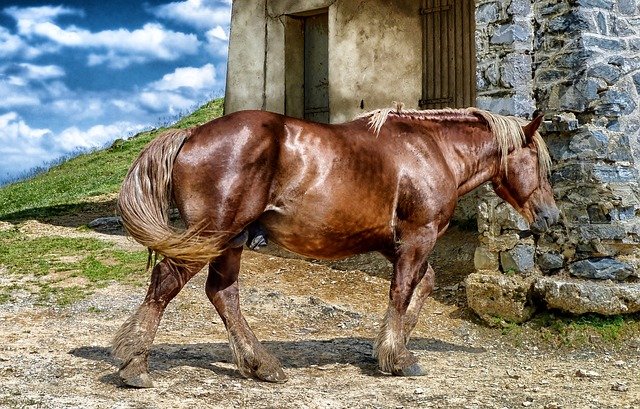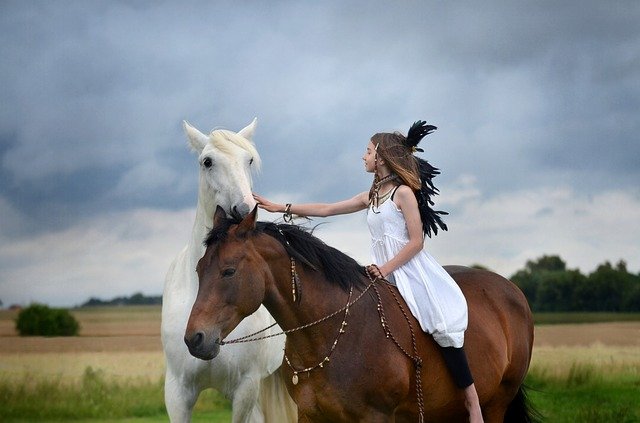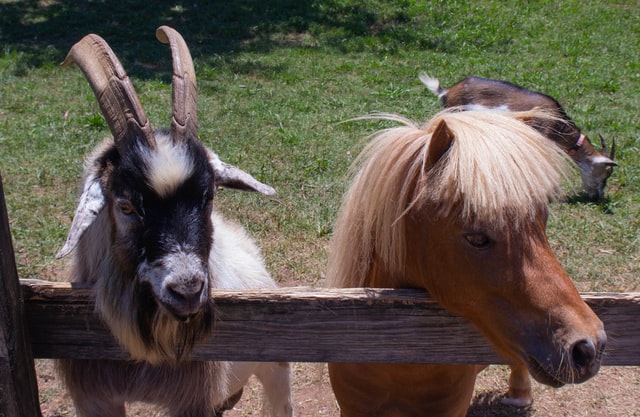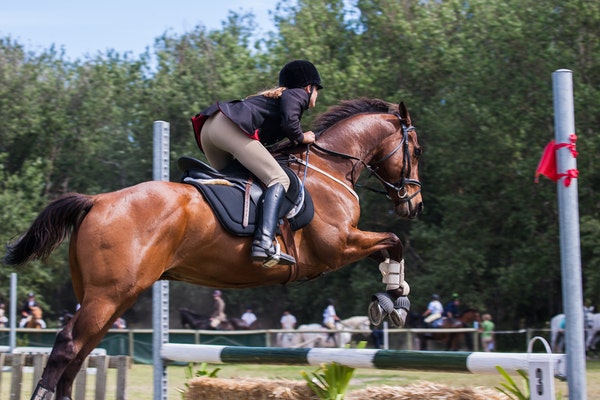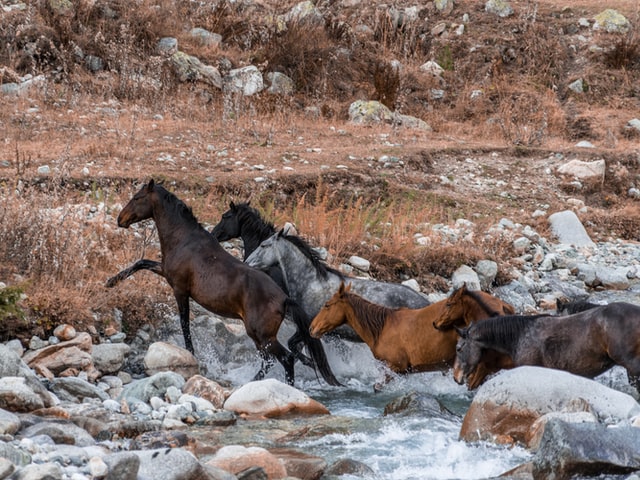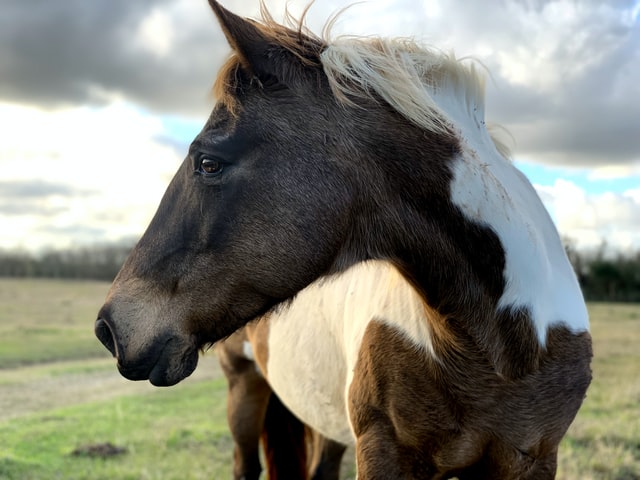The Secret of Horse Colors – What They Are and How They’re Made
Horses come in a variety of unique and beautiful colors.
In this post we’ll go over what horse colors there are and how they’re made.

There are four basic coat colors—bay, black, and chestnut.
Some people would say that brown horses are not part of these basic colors.
Aside from these basic horse colors, horses can have lighter or darker colors, as well as color patterns—Appaloosa and Paints.
Horse color genetics are mostly the reason why horses have the colors they have.
Let’s see how horses can get these colors and coat patterns.
For reference, check out my post on Beginner Horse Terms.
Horse Colors
Base Coat Colors
Common horse coat colors all draw from these base colors.
Different genes cause different shades to rise in a horse’s coat color.
All horses have certain genes called E allele and agouti genes.
The E allele is responsible for the extension or reduction of the amount of black pigment in a horse’s coat, while the A genes are responsible for keeping the blacks to the points or leaving it where it already is.
Different breeds may have different eye colors.
But for these common horse colors, finding one with blue eyes is quite rare. Most horses that come with base coat colors have brown eyes.
However, because of certain genes, other eye colors may appear just like blue, yellow, hazel, green, or amber.
Bay Horses
Both E and A genes work together to produce bay horses.
Bay horses can be seen in most horse breeds.
A common way to distinguish bay horses is to spot their dark skin and black points.
“Black points” means having a black mane, tail, and legs.
A dark bay horse can be confused with a black horse.
However, an easy way to differentiate a dark bay from a black horse is to check for any hint of dark red colors on their coat and black points.
The dun gene plays a role in why bay duns have those colors.
To differentiate bay dun horses from true bay horses, check out for a dark stripe that goes down their back, tail, and mane.
These areas in a dun horse are usually darker than any other part of their coat.
Dun horses have primitive markings that create a dorsal stripe that runs down the back of their front legs.
Other bay dun horses develop zebra stripes running in their body and are referred to as zebra duns.
When a bay horse’s dominant gene is roan, a bay roan develops and is registered as red roans.
Another scene where we can see genes playing in bay horses is in buckskin horses.
A buckskin color shows up when the red pigments from the dilution gene dilute the bay base.
This forms a creamy to yellowish coat and a black mane, tail, and lower legs.
The sandy bay is easily identified because of its black points and lightly colored coat.
The gene responsible for the light color of its coat is the cream gene.
Most of the time, buckskins and sandy bays are thought to be the same because of their colors.
When the champagne gene is dominant, the whole coat of a bay horse turns into gold.
This is why it is called the golden bay or light bay.
The light bay is the lightest variant of a bay horse’s coat.
Most quarter horses are bay.
The American Quarter Horses Association is responsible for registering quarter horses where 17 colors of these horses are accepted.
Most of these colors are derived from the bay, like dun, red dun, red roan, bay roan, and blue roan.
There are also bay horses that have black base skin just like the blue dun.
Black Horses
Black horses have black manes, black hair coats, and tails.
Black skin and dark brown eyes can be found on a true black horse.
There are two types of black horses—jet black and sun-faded black.
When a black horse spends too much time under the sun, its black color fades slightly, making them look like dark bay horses.
The way to distinguish a true black horse from bays and chestnut horses is from the hairs around their eyes and muzzles.
These areas will always be black—hit by the sun or not.
On other colors, it will have a lighter color.
Most black horses are born with a gray coat.
However, they shed their gray coat, and their pure black coat emerges.
Although the horse’s color is pure black, some black horses can have a few white markings.
Black horses are not rare, but they are uncommon.
Breeds of horses that come with a pure black coat include Friesian horses, Dales pony, the Murgese, Merens horse, and the Percherons.
Chestnut Horses
Another common color we find in horses is the chestnut color.
There are various shades to this color including liver chestnut, flaxen chestnut, light chestnut, and red chestnut.
The liver chestnut horse has a body with chocolate brown hairs, mane, and tail.
The flaxen chestnut has a reddish brown coat. It also has a flaxen mane and tail.
Unlike other chestnut horses, this type of chestnut horse is the only one that has a body that is in a different color as its mane and tail.
A light chestnut’s entire body has a sandy color, garnering its nickname, “Sandy Chestnut”.
Lastly, the fourth shade of chestnut is called the red chestnut.
A different name for them is sorrel. Sorrel horses are the most common for chestnuts.
They have a red coat and are sometimes usually described as red horses.
Breeds with chestnut base colors are the American paint horse, Appaloosa, Icelandic, and the Pony of America.
There are other breeds, too, but these breeds are the easy-to-spot ones.
Most of the time, we decide on a horse’s color based on its body color.
But, the colors of their mane, coat, and tails could help us distinguish them more accurately.
Non-Basic Horse Colors
Gray and white horses are not exactly basic colored horses.
These horses have certain genes which make them a bit more interesting.
Some of them develop patterns, too, which sets them apart.
Gray horses aren’t born gray.
They are usually born with a dark color that fades to gray over time.
Again, it is because of a gene that they have that turns them gray.
Sometimes, gray horses grow old and become white.
The most common
White horses are rare. It is very rare to find a white horse with pink skin, brown eyes, a white face, and white hair.
In a white horse, we find a gene called white spotting, which helps develop white spots around the horse’s body.
Another reason why horses develop a white coat is when two copies of the Sabino 1 gene meet, it is expected to produce a true white horse.
This gene is the reason why Sabinos have white patches in their bodies.
However, for some breeds, giving birth to a white foal means giving birth to a foal that is bound to die—within 3 days.
This is why foals from this breed, when born white, are euthanized.
Horse Colors – Patterns
Some horses develop patterns on their skin.
While their base color defines their hair color, white patterns usually define where and how many white hairs show up.
The most usual patterned horse is the Pinto horse.
Pinto horses have many colors.
Their body is filled with large patches of white and brown or black.
The Pinto horses develop these patches because it has an allele that is responsible for the spotting patterns.
These large patches make it easy to spot Pinto horses.
One example of a Pinto horse that one could easily spot is the Tobiano pattern.
This pattern is easily seen as it makes round patterns with white legs and white patterns across the back.
The silver dapple is another patterned horse.
Its mane and tail have a particular color—silver, and its coat is dappled.
This effect happens because the dilution gene works and dilutes the black pigment.
And, more often than not, dappling comes with it, too.
These are just general terms that most horse owners are familiar with.
Learn and understand more about horse genetics and see how a play of genetics can change the colors of horses here!

Lauren is an internationally published author, trainer, and has helped hundreds of horse-rider combinations create lasting bonds and the success they desire. Check out Lauren’s incredible story: From horse-crazy girl to international equine educator. Or if you want to send Lauren a quick message, check out her contact page here.
